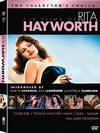





Cathy O'Donnell
Biography | Filmography | Articles | Bibliography | Downloads | Links | Image Credits | THE BEST YEARS OF OUR LIVES | BEN-HUR
| Biography: |
|
ANN STEELY was born to Henry Grady Steely, a school teacher and local theatre operator, and his wife Ora Lecher Steely, on July 6, 1923 in the small town of Siluria, Alabama. Ann attended elementary school in Greensboro, Alabama, but her father died in 1935, and at age twelve, she moved with her mother and younger brother, Joe, to Oklahoma City. In Oklahoma she attended Harding Junior High School and graduated from Classen High School in 1942. Between 1942 and 1943, Ann studied stenography at Hill's Business College and dramatics at Oklahoma City University where she appeared in some student productions. Upon leaving school, she got a job as a secretary with Oklahoma City's army induction center, but had caught the acting bug, and in 1944, packed her bags to try her luck in Hollywood. Ann's only contact in the movie industry was photographer Paul Hesse who did his best to introduce her to people, but her break came while sitting at a lunch counter in Schwab's drugstore. There she met an agent named Ben Medford who offered to introduce her to producer Samuel Goldwyn. Goldwyn ordered a screen test and signed Ann to a standard seven-year contract. Because she had no professional experience, he sent her to the American Academy of Dramatic Arts in New York where she studied acting, ballet and diction. (Goldwyn reportedly couldn't understand her southern accent.) After losing her accent and changing her name to Cathy O'Donnell ("Cathy" after the character in Wuthering Heights and "O'Donnell" because Goldwyn thought an Irish name would suit her), she toured for six months as Mary in "Life With Father" before returning to Hollywood. In 1946 Cathy made her screen debut in Goldwyn's production of William Wyler's THE BEST YEARS OF OUR LIVES (1946). The film featured a flock of Hollywood stars including Fredric March, Myrna Loy, Dana Andrews, Teresa Wright and Virginia Mayo, but Cathy played the love interest of another screen newcomer, disabled veteran Harold Russell. BEST YEARS earned seven Academy Awards including the Oscar for Best Picture. The following year, Cathy's talents were loaned out to other studios, most notably RKO for whom she made THEY LIVE BY NIGHT (1948) opposite Farley Granger, another newly signed Goldwyn contract player. (The film was shelved temporarily by the studio and not released in the United States until 1949, after receiving critical plaudits in Britain the previous year). In 1948, Cathy and Granger returned to the Goldwyn lot where they were cast together with David Niven and Teresa Wright in the film adaptation of Rumer Godden's novel Take Three Tenses. However, when on April 11 she eloped with Robert Wyler, brother of BEST YEARS director William Wyler (who had left Goldwyn after making the film to form an independent production company), Goldwyn fired her then and there. As Farley Granger explained: "Goldwyn took this situation personally and said that Willy Wyler had put his brother up to marrying Cathy just to spite him... And he insisted that Cathy annul the marriage immediately or she would never work again."(1) Evelyn Keyes replaced Cathy in ENCHANTMENT (1948) (as Take Three Tenses was eventually called), and Cathy signed with David O. Selznick. Cathy's career waned after the break with Goldwyn. She appeared as a grown-up Judy Miniver in the 1950 box office flop THE MINIVER STORY, a sequel to the Best Picture of 1942 MRS. MINIVER with Greer Garson and Walter Pidgeon. That same year, a second pairing with Granger, SIDE STREET, failed to connect with audiences as had THEY LIVE BY NIGHT. In 1951, Cathy had a small but worthwhile role in DETECTIVE STORY, directed by William Wyler, and the lead in an inconsequential film called NEVER TRUST A GAMBLER. After other small roles, most notably in Anthony Mann's THE MAN FROM LARAMIE (1955) with Jimmy Stewart, Cathy made her final big screen appearance for Wyler in his 1959 epic BEN-HUR. She played Charlton Heston's leprosy-stricken sister Tirzah. Although she did a little work in television through 1964, Cathy's acting career had essentially ended. After a lengthy battle with cancer, she died on April 11, 1970, her twenty-second wedding anniversary with Robert Wyler, who died the following year. The couple had no children. Footnotes: |
|
Return to the Cathy O'Donnell main page. |
| Now in Print! |
|---|
| Now on DVD! |
|---|
Buy Videos & DVDs |
|
Buy Movie Posters |
|
Buy Movie Posters |
|
Classic
Movie Merchandise |
|
![]() Printer-friendly version.
Printer-friendly version.
![]() Return
to the top.
Return
to the top.
Last updated:
March 10, 2011.
Reel Classics is a registered trademark of Reel Classics, L.L.C.
© 1997-2011 Reel Classics, L.L.C. All rights reserved. No
copyright is claimed on non-original or licensed material.
Terms of
Use.









